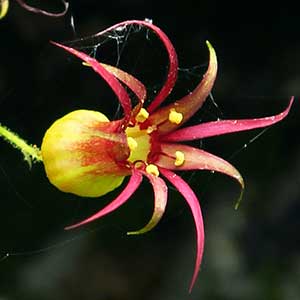Bolandra oregana
Bolandra
northern false coolwort, Oregon bolandra
bolandra, false coolwort
erect to ascending, leafy, 10–40 cm, stipitate-glandular.
petiole 3–15 cm;
blade shallowly lobed, 2–7 cm, ultimate margins serrate.
in basal rosette and cauline;
cauline leaves conspicuous, reduced and bractlike distally;
stipules present;
petiole glabrous;
blade reniform to orbiculate, 5–13-lobed, base cordate, ultimate margins irregularly serrate to crenate-dentate, apex obtuse to acute, surfaces glabrous;
venation palmate.
6–18-flowered, 16–40 cm, stipitate-glandular;
bracts subtending pedicels conspicuous, auriculate.
compound, dichasial cymes, terminal from terminal bud in basal rosette, 5–18-flowered, bracteate.
hypanthium campanulate-urceolate, 5–10 mm, glabrous;
sepals 6–10 mm, apex long-acuminate;
petals usually reddish purple to dark purple, narrowly lanceolate, unlobed, 7–12(–14) mm, apex long-tapered;
stamens included, 2 mm;
ovaries connate proximally 1/4 their lengths;
styles barely exserted, 2 mm;
stigmas distinct.
hypanthium free from ovary, greenish to purple;
sepals 5, greenish to purple, (narrowly triangular to triangular-ovate);
petals 5, greenish with purple margins or reddish purple to dark purple;
nectary tissue not seen;
stamens 5;
filaments filiform;
ovary nearly superior, 2-locular, ovaries connate 1/4–1/2 their lengths;
placentation axile;
styles 2;
stigmas 2.
brown, ovoid, 8–9 mm.
2-beaked.
100–125, 0.7–9 mm.
dark brown, prismatic (or angular) and fusiform, minutely tuberculate.
= 7.
= 14.
Bolandra oregana
Bolandra
Bolandra oregana is found in northern Oregon and southern Washington in the vicinity of the Columbia River gorge and in the Snake River region of eastern Oregon and Idaho.
(Discussion copyrighted by Flora of North America; reprinted with permission.)
Species 2 (2 in the flora).
Both the monograph by R. J. Gornall and B. A. Bohm (1985) and the molecular systematic work of D. E. Soltis et al. (1993) support a close relationship among Bolandra, Boykinia, and Suksdorfia. Other genera that appear to be closely related to these are Jepsonia, Sullivantia, and Telesonix (Soltis et al.).
(Discussion copyrighted by Flora of North America; reprinted with permission.)
1. Leaf blades deeply lobed, ultimate margins crenate-dentate; ovaries connate proximally 1/2 their lengths; petals usually greenish with purple margins, 4-5(-7) mm. | B. californica |
1. Leaf blades shallowly lobed, ultimate margins serrate; ovaries connate proximally 1/4 their lengths; petals usually reddish purple to dark purple, 7-12(-14) mm. | B. oregana |
- Local floras:
CA,
OR,
WA
- Local Web sites:
CalFlora,
CalPhotos,
Flora NW,
PNW Herbaria
WildflowerSearch
iNaturalist (observations)
USDA Plants Database
- LBJ Wildflower Center
- SEINet
- Plants of the World Online
- Encyclopedia of Life
- Wikipedia
- Google Image Search


